So how does this one compare to the findings reviewed in Do Libraries Cater for Today's Undergraduate Students? and Do Libraries Cater for Today's Researchers and Research Students?...?
Many students in our sample used a strategy for finding information and conducting research that leveraged scholarly sources and public Internet sites and favored brevity, consensus, and currency in the sources they sought.
And as with the other reports, it seems that Google's up there when doing course related research:
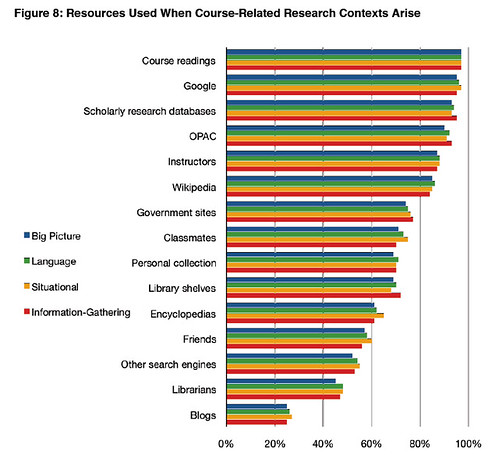
as well as "personal" research...
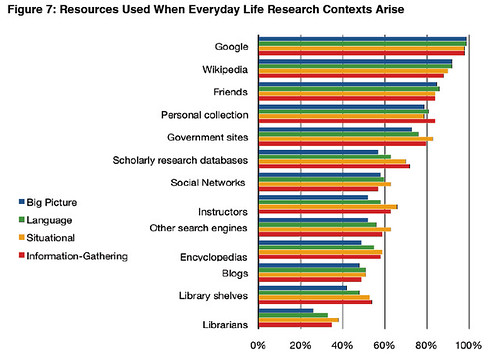
The four categories reported in the above charts relate to the following typology which identifies the different ways in which students appear to approach a research topic:
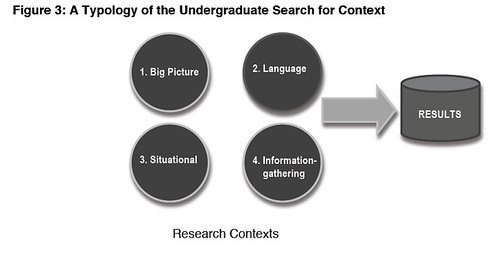
The categories are defined as follows:
1. Big picture: Finding out background for defining and selecting a topic.
2. Language: Figuring out what words and terms associated with a topic may mean.
3. Situational: Gauging how far to go with research, based on surrounding circumstances.
4. Information-gathering: Finding, accessing, and securing relevant research resources.
To my mind, these research contexts relate to different ways in which a student may be said to be familiarising themselves with a particular topic, and leveling their understanding of the ideas contained within it. Maybe the term "presearch" is also relevant here?
Finding big picture context may indeed be part of what some students have called a “presearch stage.” Presearch is a time of thinking about and narrowing down a topic.
So what problems to students admit to having with respect to their research activities?
... students also reported they used different resources and workarounds that sometimes helped (and sometimes did not) as they tried to find the contexts they needed.
For most students, it was during these research interactions—the use of certain information resources to find different research contexts—when difficulties, frustrations and challenges arose.
Respondents stated that many of these frustrations were the effects of information overload and the sense of being inundated by all the resources at their disposal. We also found that students were challenged by their inability to find the materials they desired and needed on a “just in time” basis, especially if they had procrastinated on course-related research assignments.
A question of "appropriate tools for the job"...?
“When I’m doing research, usually it’s the material that I have from the class, or the stuff I’m looking up from the library databases. But if I don’t understand something from those things like a word or a concept, then I’ll go a search engine, or if I just need quick facts or something like that, I’ll use a search engine to find them.”
Student in a followup interview
So my reading of this is that students are comfortable with the way that "the web" can provide them with context at their level, and help them make sense of ideas presented to them through academic materials via a socially mediated filter (the Google algorithm, the link economy and the click-thru behaviour of other searchers!) That is, Google exposed "web sense" (cf. common sense...?) helps students make personal sense of their research topic through things that others researching the same topic have previously found useful...
Viewed this way, a concern raised by the report authors suddenly makes sense:
In our fall student discussion sessions we identified gaps between how faculty conducted research (usually primary research), especially at research institutions, and how students conducted research (usually secondary research) for course-related research. The gap in what research was and how it was conducted by each group, in this case, was the basis for frustrations with meeting instructorsʼ expectations for course-related research assignments.
This gap in part arises because of the difference between the "approved" (re)search process:

and what I would claim is the students' use of web search engines to aid sensemaking and interpretation of scholarly resources (rather than for resource discovery, say... That is, the search is not for resources to cite, it's for "notes" that help them interpret or make sense of the (concepts contained in the) resources they are going to cite...)
This tension between how students do (re)search and "formal" models of how it should be done is also considered in the report:
1. Library guides often recommend a strategy for scholarly information seeking, underscored by the use of credible, authoritative sources. These sources are more likely to bring success by resolving many of the credibility issues facing digital natives.
2. The student approach is based on efficiency and utility. The student strategy attempts to satisfy context needs (identifying and developing a topic) by using a combination of instructor-sanctioned sources (i.e., course readings) and with open-access, collaborative public Internet resources (i.e., Google and Wikipedia) that return a lot of results early on.
That is:
As a whole, the findings suggest that students in our sample favored sources for their brevity, consensus, and currency over other qualities and less so, for their scholarly authority.
In the previous reports referred to at the start of this post, we saw that respondents did not necessarily call on the direct services of librarians; what did this report find?
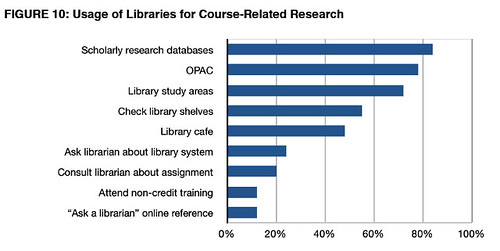
No change there, then! However, it was reported that "respondents who needed to fill a language context need were more than 1.5 times more likely to consult librarians than were respondents who did not have a language need". That is: "please, Sir, Miss, what word should I use here?"
“It’s kind of tough to answer why I use librarian, but is really more when I’m trying to think of the word to use, how to narrow my search, so it’s not such a huge list to choose stuff from. Say you are searching a certain kind of plant, or something, and you end up with a 100 plus things to look and they are not even necessarily what you need, so you want to know how to cancel those out and have a narrower search—librarians help you with that process of narrowing a search down.”
Student follow-up interview
And again:
Students in our sample were much more likely to use a librarian when they needed help finding the meaning of a word or term related to a topic or figuring out what search terms to use. Also, respondents were more likely to turn to librarians for help with finding full text materials that were available from different sources.
So where are we at? Students use Google, and sometimes they ask for help about vocabulary. And if they do actually use subscription databases, what do they see as the benefits?
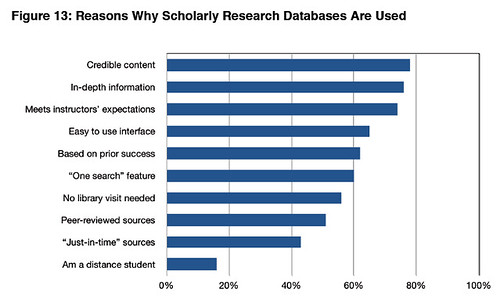
In other words:
The perceived reliability of content found on scholarly research databases was the most significant driver for respondentsʼ use. A majority of respondents (78%) used databases because they were a source of credible information—more so than what students might find elsewhere on the Internet. In addition, three-fourths of the sample (76%) used databases for the in-depth, detailed information, often found in journal articles, they could find with a keystroke.
Referring back to Figure 8 from the report (shown above) about resources used for course related searches, instructors rather than librarians scored highly as an important resource. So how did instructor support manifest itself?
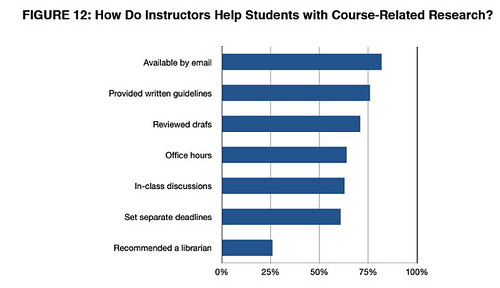
Taken as a whole, these results suggest that most respondents definitely included instructors in some role during their course-related research workflow. In particular, respondents turned to instructors for coaching throughout the entire research process from defining a topic to developing an information seeking strategy to writing up their final papers.
On the upside, we could say that instructors are embdding infoskills in their teaching and support of students. Which means what?
We have come to believe that many students see instructors—not librarians—as coaches on how to consult research. This situation seems to occur whether the faculty may qualify as expert researchers in the area of student research methods, or not. Librarians and faculty should see the librarian-student disconnect as a timely opportunity, especially when it comes to transferring information competencies to students.
We recommend librarians take an active role and initiate the dialogue with faculty to close a divide that may be growing between them and faculty and between them and students—each campus is likely to be different. ... No matter what the means of communication may be, however, librarians need to actively identify opportunities for training faculty as conduits for reaching students with sound and current information-seeking strategies, as it applies to their organizational settings.
Finally, a question occurred to me whilst I was reading the report: If you viewed Google as a member of Library Staff, which staff member (role or actual person) would they be? If you had to write a job description for what Google currently does, and what it could do, what would that job description look like? Is there a post that fulfills a similar role in your Library already? If not, why not?
As the report puts it:
Librarians should systematically (not just anecdotally) examine the services they provide to students. This may require looking at things through a new lens, if need be. Questions should be addressed about how and why services and resources are used—not only how often (e.g., circulation or reference desk statistics). Librarians may want to initiate their analysis by asking what percentage of their campus are using the library, for what particular resources or services, and why or why not? At the same time, we recommend librarians seriously question whether they are developing a set of “niche services,” which only reach a small percentage of students.
You have been warned... ;-)



No comments:
Post a Comment